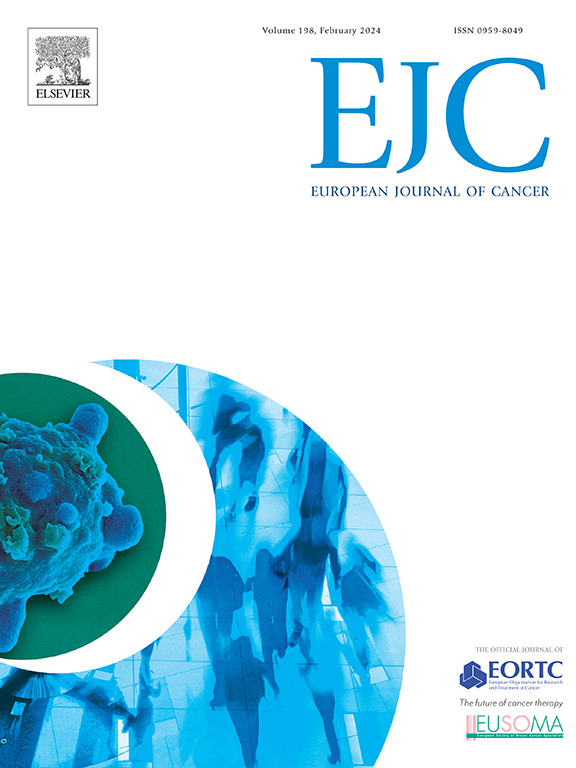Mapping the potential for anti-PD-1 therapy in advanced rare skin carcinomas
IF 7.6
1区 医学
Q1 ONCOLOGY
引用次数: 0
Abstract
This review, focusing on cutaneous adnexal carcinomas, extramammary Paget disease (EMPD), cutaneous angiosarcomas (cAS) and Kaposi sarcoma (KS), summarizes their local recurrence and metastasis rates, tumor mutation burden (TMB), PD-L1 expression, and off-label treatment with systemic anti-PD-1 agents. PD-L1 expression and tumor mutation burden (TMB) were highly variable in adnexal carcinomas (also depending on the histological subtype), cAS and KS tumors, and some responses were noted even in lack of PD-L1 expression or in low-TMB tumors. There were encouraging best overall responses in patients with advanced rare skin carcinomas treated with anti-PD-1 agents in the literature, mostly after failure of other systemic treatments. We identified a total of 3 patients with sebaceous carcinoma (2 with complete response [CR], 1 with partial response [PR]), 5 with porocarcinoma (3 CR, 1 PR, 1 progression of disease [PD]), 2 with spiradenocarcinoma (1 PR, 1 PD), 1 with trichilemmal carcinoma with PR, 9 with EMPD (1 CR, 5 PR, 3 PD), 32 with cAS (5 CR, 18 PR, 9 PD), and 92 with KS (5 CR, 53 PR, 23 SD, 11 PD). However, a large variety of anti-PD-1 agents were used, in monotherapy or in combination with other systemic therapy, in a relatively small number of patients, limiting interpretations on their individual efficacy. The development of clinical guidelines on rare skin carcinomas may provide standardized guidance to physicians towards best care.
绘制晚期罕见皮肤癌抗pd -1治疗的潜力
本文综述了皮肤附件癌、乳腺外佩吉特病(EMPD)、皮肤血管肉瘤(cAS)和卡波西肉瘤(KS)的局部复发和转移率、肿瘤突变负担(TMB)、PD-L1表达以及全身抗pd -1药物的超说明书治疗。PD-L1表达和肿瘤突变负荷(TMB)在附件癌(也取决于组织学亚型)、cAS和KS肿瘤中变化很大,甚至在PD-L1缺乏表达或低TMB肿瘤中也有一些反应。在文献中,使用抗pd -1药物治疗的晚期罕见皮肤癌患者的总体反应令人鼓舞,主要是在其他全身治疗失败后。我们共确定了3例皮脂腺癌患者(2例完全缓解[CR], 1例部分缓解[PR]), 5例骨质疏松癌患者(3例完全缓解,1例部分缓解,1例疾病进展[PD]), 2例螺旋腺癌患者(1例PR, 1例PD), 1例毛突癌合并PR, 9例EMPD患者(1例CR, 5例PR, 3例PD), 32例cAS患者(5例CR, 18例PR, 9例PD), 92例KS患者(5例CR, 53例PR, 23例 SD, 11例PD)。然而,在相对较少的患者中,使用了种类繁多的抗pd -1药物,无论是单独治疗还是与其他全身治疗联合使用,这限制了对其个体疗效的解释。罕见皮肤癌临床指南的制定可以为医生提供标准化的最佳护理指导。
本文章由计算机程序翻译,如有差异,请以英文原文为准。
求助全文
约1分钟内获得全文
求助全文
来源期刊

European Journal of Cancer
医学-肿瘤学
CiteScore
11.50
自引率
4.80%
发文量
953
审稿时长
23 days
期刊介绍:
The European Journal of Cancer (EJC) serves as a comprehensive platform integrating preclinical, digital, translational, and clinical research across the spectrum of cancer. From epidemiology, carcinogenesis, and biology to groundbreaking innovations in cancer treatment and patient care, the journal covers a wide array of topics. We publish original research, reviews, previews, editorial comments, and correspondence, fostering dialogue and advancement in the fight against cancer. Join us in our mission to drive progress and improve outcomes in cancer research and patient care.
 求助内容:
求助内容: 应助结果提醒方式:
应助结果提醒方式:


